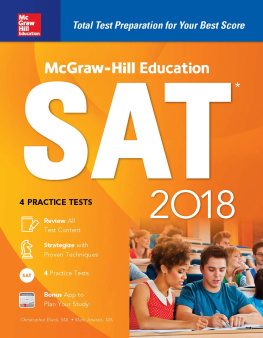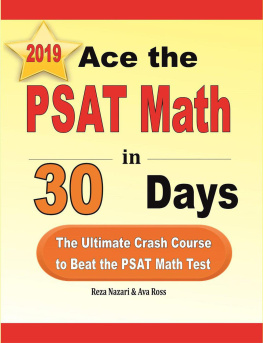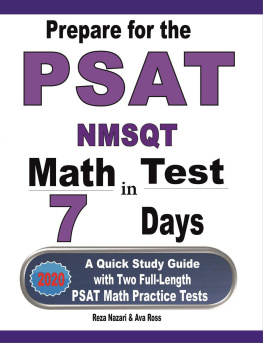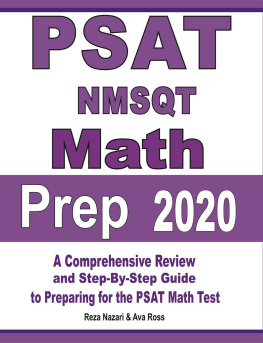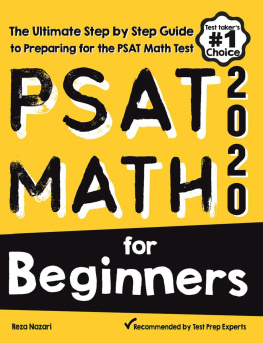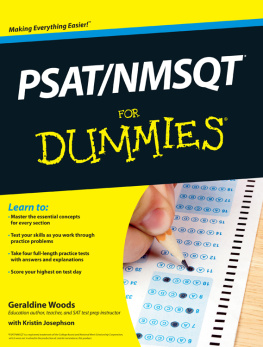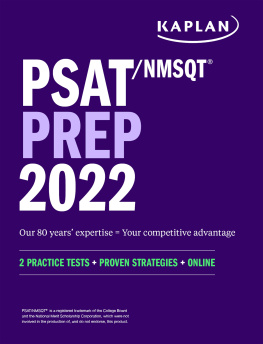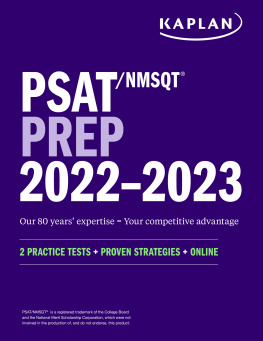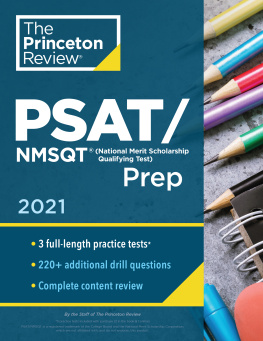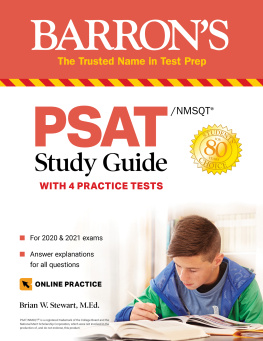McGRAW-HILLs PSAT/NMSQT
Second Edition
CHRISTOPHER BLACK
MARK ANESTIS
and the TUTORS of COLLEGE HILL COACHING

McGRAW-HILLs PSAT/NMSQT

Copyright 2010, 2006 by The McGraw-Hill Companies, Inc. All rights reserved. Except as permitted under the United States Copyright Act of 1976, no part of this publication may be reproduced or distributed in any form or by any means, or stored in a database or retrieval system, without the prior written permission of the publisher.
ISBN: 978-0-07-174212-2
MHID: 0-07-174212-3
The material in this eBook also appears in the print version of this title: ISBN: 978-0-07-174211-5, MHID: 0-07-174211-5.
All trademarks are trademarks of their respective owners. Rather than put a trademark symbol after every occurrence of a trademarked name, we use names in an editorial fashion only, and to the benefit of the trademark owner, with no intention of infringement of the trademark. Where such designations appear in this book, they have been printed with initial caps.
McGraw-Hill eBooks are available at special quantity discounts to use as premiums and sales promotions, or for use in corporate training programs. To contact a representative please e-mail us at bulksales@mcgraw-hill.com.
TERMS OF USE
This is a copyrighted work and The McGraw-Hill Companies, Inc. (McGraw-Hill) and its licensors reserve all rights in and to the work. Use of this work is subject to these terms. Except as permitted under the Copyright Act of 1976 and the right to store and retrieve one copy of the work, you may not decompile, disassemble, reverse engineer, reproduce, modify, create derivative works based upon, transmit, distribute, disseminate, sell, publish or sublicense the work or any part of it without McGraw-Hills prior consent. You may use the work for your own noncommercial and personal use; any other use of the work is strictly prohibited. Your right to use the work may be terminated if you fail to comply with these terms.
THE WORK IS PROVIDED AS IS. McGRAW-HILL AND ITS LICENSORS MAKE NO GUARANTEES OR WARRANTIES AS TO THE ACCURACY, ADEQUACY OR COMPLETENESS OF OR RESULTS TO BE OBTAINED FROM USING THE WORK, INCLUDING ANY INFORMATION THAT CAN BE ACCESSED THROUGH THE WORK VIA HYPERLINK OR OTHERWISE, AND EXPRESSLY DISCLAIM ANY WARRANTY, EXPRESS OR IMPLIED, INCLUDING BUT NOT LIMITED TO IMPLIED WARRANTIES OF MERCHANTABILITY OR FITNESS FOR A PARTICULAR PURPOSE. McGraw-Hill and its licensors do not warrant or guarantee that the functions contained in the work will meet your requirements or that its operation will be uninterrupted or error free. Neither McGraw-Hill nor its licensors shall be liable to you or anyone else for any inaccuracy, error or omission, regardless of cause, in the work or for any damages resulting there from. McGraw-Hill has no responsibility for the content of any information accessed through the work. Under no circumstances shall McGraw-Hill and/or its licensors be liable for any indirect, incidental, special, punitive, consequential or similar damages that result from the use of or inability to use the work, even if any of them has been advised of the possibility of such damages. This limitation of liability shall apply to any claim or cause whatsoever whether such claim or cause arises in contract, tort or otherwise.
Visit http://www.mhpracticeplus.com/psat.php to get additional complete PSAT Practice tests on your own computer.
CONTENTS
ACKNOWLEDGMENTS
We would like to gratefully acknowledge the help of those who have contributed to this enormous project and have been committed to its success. This project would not have been the same without the help of so many of our close friends and relatives: Elizabeth Black, the worlds greatest teacher of mathematics, for her many years of patience, wisdom and gracious support; Sarah and Anna Black for their constant inspiration and marvellous good humor; Stephanie Anestis for her invaluable efforts in reading and editing the text and for her incredible love and support; Robert, Janice, Michael, and Matthew Anestis who also gave their insight on the work in progress; and Andrew Hathaway, the legendary and inspirational Mr. Zip-ZapZup. We would also like to thank Brigid Barry, Aulden Kaye, Peter Obourn, Kristoffer Shields and the brilliant tutors of College Hill Coaching for their thoughtful and valuable assistance. We appreciate the hard work of those at McGraw-Hill who made this project work and the thoughtful help of our agent, Grace Freedson. Finally, we would like to thank all the students of College Hill Coaching who have contributed to the growth of these materials over the years; their insight and experiences have thoroughly inspired and informed this book.
CHAPTER 1
WHAT YOU NEED TO KNOW ABOUT THE PSAT/NMSQT
1 QUESTIONS AND ANSWERS ABOUT THE PSAT/NMSQT
What is the PSAT/NMSQT?
The PSAT/NMSQT (Preliminary SAT and National Merit Scholarship Qualifying Test) is a 2 hour and 10 minute-long test administered each October to high school sophomores and juniors throughout the country. It consists of three parts: Critical Reading, Math, and Writing. It is essentially an abbreviated form of the SAT (which is just under 4 hours long) without the essay.
PSAT scores are not used for college admission, but they are used to select National Merit Scholars. However, since only the top 4% of test takers actually earn National Merit honors, most students take the PSAT primarily as a practice run for the SAT, which they will take in the spring of junior year.
How is the PSAT scored, and what do the scores mean?
You will receive three scores on your PSATCritical Reading, Math, and Writingeach ranging from 20 to 80. The sum of these three scores is your NMSQT selection index, which can range from 60 to 240. The scaled scores are based on the raw scores for each section. Every correct answer increases your raw score for that section by 1 point, and every wrong answer decreases your raw score for that section by 1/4 point, except for wrong answers on math grid-in questions, which do not decrease your raw score. Unanswered questions are worth 0 points to your raw score.
PSAT scores are scaled so that a 50 represents roughly the median of all scores. In other words, a score of 50 on any section of the PSAT will outscore about 50% of all students taking the test. Also, a score of 55 on any section outscores about 66% of all students, a 60 outscores about 85% of all students, and a score of 70 outscores about 97% of all students. Of course, these numbers vary slightly from year to year and from state to state.
Will colleges see my PSAT scores?
No. Dont worry about colleges judging you on your PSAT scores. When you register for the PSAT, however, you will have the option of giving colleges permission to send you information about their schools. These schools will simply receive your profile and, if they are interested in having you apply, send you brochures and other information in your junior year. Also, if you qualify as a National Merit Scholar, you will be given the opportunity to notify two colleges or universities that you have received this honor.
What skills does the PSAT assess?


